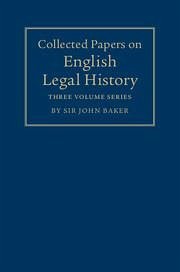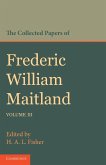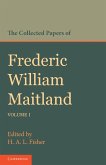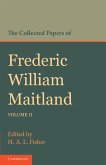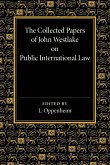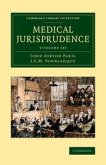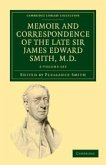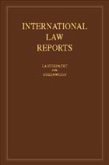John Baker
Collected Papers on English Legal History 3 Volume Set
John Baker
Collected Papers on English Legal History 3 Volume Set
- Broschiertes Buch
- Merkliste
- Auf die Merkliste
- Bewerten Bewerten
- Teilen
- Produkt teilen
- Produkterinnerung
- Produkterinnerung
Sir John Baker's writings touch on most aspects of English legal history, especially the legal profession and its learning.
Andere Kunden interessierten sich auch für
![The Collected Papers of Frederic William Maitland The Collected Papers of Frederic William Maitland]() Frederic William MaitlandThe Collected Papers of Frederic William Maitland58,99 €
Frederic William MaitlandThe Collected Papers of Frederic William Maitland58,99 €![The Collected Papers of Frederic William Maitland The Collected Papers of Frederic William Maitland]() Frederic William MaitlandThe Collected Papers of Frederic William Maitland58,99 €
Frederic William MaitlandThe Collected Papers of Frederic William Maitland58,99 €![The Collected Papers of Frederic William Maitland The Collected Papers of Frederic William Maitland]() Frederic William MaitlandThe Collected Papers of Frederic William Maitland58,99 €
Frederic William MaitlandThe Collected Papers of Frederic William Maitland58,99 €![The Collected Papers of John Westlake on Public International Law The Collected Papers of John Westlake on Public International Law]() The Collected Papers of John Westlake on Public International Law65,99 €
The Collected Papers of John Westlake on Public International Law65,99 €![Medical Jurisprudence 3 Volume Set Medical Jurisprudence 3 Volume Set]() John Ayrton ParisMedical Jurisprudence 3 Volume Set206,99 €
John Ayrton ParisMedical Jurisprudence 3 Volume Set206,99 €![Memoir and Correspondence of the Late Sir James Edward Smith, M.D. 2 Volume Set Memoir and Correspondence of the Late Sir James Edward Smith, M.D. 2 Volume Set]() James Edward SmithMemoir and Correspondence of the Late Sir James Edward Smith, M.D. 2 Volume Set164,99 €
James Edward SmithMemoir and Correspondence of the Late Sir James Edward Smith, M.D. 2 Volume Set164,99 €![International Law Reports Set 190 Volume Hardback Set International Law Reports Set 190 Volume Hardback Set]() E. Lauterpacht / C. J. Greenwood (eds.)International Law Reports Set 190 Volume Hardback Set34.792,99 €
E. Lauterpacht / C. J. Greenwood (eds.)International Law Reports Set 190 Volume Hardback Set34.792,99 €-
-
-
Sir John Baker's writings touch on most aspects of English legal history, especially the legal profession and its learning.
Hinweis: Dieser Artikel kann nur an eine deutsche Lieferadresse ausgeliefert werden.
Hinweis: Dieser Artikel kann nur an eine deutsche Lieferadresse ausgeliefert werden.
Produktdetails
- Produktdetails
- Verlag: Cambridge University Press
- Seitenzahl: 1664
- Erscheinungstermin: 9. Dezember 2013
- Englisch
- Abmessung: 249mm x 165mm x 107mm
- Gewicht: 3402g
- ISBN-13: 9781107020436
- ISBN-10: 1107020433
- Artikelnr.: 38263482
- Herstellerkennzeichnung
- Libri GmbH
- Europaallee 1
- 36244 Bad Hersfeld
- gpsr@libri.de
- Verlag: Cambridge University Press
- Seitenzahl: 1664
- Erscheinungstermin: 9. Dezember 2013
- Englisch
- Abmessung: 249mm x 165mm x 107mm
- Gewicht: 3402g
- ISBN-13: 9781107020436
- ISBN-10: 1107020433
- Artikelnr.: 38263482
- Herstellerkennzeichnung
- Libri GmbH
- Europaallee 1
- 36244 Bad Hersfeld
- gpsr@libri.de
Sir John Baker taught at the University of Cambridge from 1971 to 2011, latterly as Downing Professor of the Laws of England. He also served for thirty years as Literary Director of the Selden Society and was knighted for services to legal history in 2003.
1. The English legal profession, 1450-1550
2. Counsellors and barristers
3. Solicitors and the law of maintenance, 1590-1640
4. The degree of barrister
5. Audience in the courts
6. The rank of Queen's Counsel
7. The third university of England
8. The Inns of Court in 1388
9. The division of the Temple: Inner, Middle and Outer
10. The Inn of the Outer Temple
11. The Old Constitution of Gray's Inn
12. The Ancient and Honourable Society of Gray's Inn
13. The Inns of Court and Chancery as voluntary associations
14. The judges as visitors to the Inns of Court
15. Oral instruction in land law and conveyancing, 1250-1500
16. Legal education in London, 1250-1850
17. The Pekynnes
18. Learning exercises in the medieval Inns of Court and Chancery
19. The Old Moot Book of Lincoln's Inn
20. Readings in Gray's Inn, their decline and disappearance
21. The Inns of Court and legal doctrine
22. Roman law at the third university of England
23. The Inns of Court: law school or finishing school?
24. The changing concept of a court
25. From lovedays to commercial arbitration
26. Personal actions in the High Court of Battle Abbey, 1450-1602
27. Judicial Conservatism in the Tudor Common Pleas, 1500-1560
28. The common lawyers and the Chancery: 1616
29. The three languages of the common law
30. Case-law in medieval England
31. Dr Thomas Fastolf and the history of law reporting
32. John Bryt's reports and the year books of Henry IV
33. Case-law in England and continental Europe
34. The books of the common law, 1440-1557
35. English law books and legal publishing, 1557-1695
36. Books of entries
37. Manuscripts in the Inner Temple
38. Common lawyers' libraries before 1640
39. John Rastell and the terms of the law
40. Coke's notebooks and the sources of his reports
41. John Selden and English legal history
42. The Newe Littleton
43. Sir Thomas Robinson
44. Westminster Hall
45. English judges' robes, 1350-2008
46. The earliest serjeants' rings
47. The collar of SS
48. The mystery of the Bar gown
49. Personal liberty under the common law, 1200-1600
50. An English view of the Anglo-Hibernian Constitution in 1670
51. Human rights and the rule of law in Renaissance England
52. Equity and public law in England
53. Some early Newgate reports, 1315-26
54. The refinement of English criminal jurisprudence, 1500-1848
55. Criminal courts and procedure, 1550-1800
56. Torture and the law of proof
57. The Tudor law of treason
58. Criminal justice at Newgate, 1616-27
59. Le brickbat que narrowly mist
60. The history of the common law of contract
61. Covenants and the law of proof, 1290-1321
62. New light on Slade's case
63. The origins of the 'doctrine' of consideration, 1535-85
64. Privity of contract in the common law before 1680
65. The rise and fall of freedom of contract
66. The law merchant and the common law before 1700
67. The law merchant as a source of English law
68. The use of assumpsit for restitutionary money claims, 1500-1800
69. Bezoar-stones, gall-stones, and gem-stones: the action on the case for deceit
70. The common law of negligence, 1500-1700
71. Dower of personalty, 1250-1450
72. Sir John Melton's case, 1535
73. Funeral monuments and the heir
74. Charity and perpetuity: the commemoration of benefactors
75. The dark age of English legal history, 1500-1700
76. Editing the sources of English legal history
77. Kiralfy's action on the case
78. Words and fictions: male and married spinsters
79. Legal process as reported in correspondence
80. 'Authentic testimony'?: fact and law in legal records
81. English law and the Renaissance
82. The common law in 1608
83. Why the history of English law has not been finished
84. Why should undergraduates study legal history?
Bibliography of writings by Sir John Baker.
2. Counsellors and barristers
3. Solicitors and the law of maintenance, 1590-1640
4. The degree of barrister
5. Audience in the courts
6. The rank of Queen's Counsel
7. The third university of England
8. The Inns of Court in 1388
9. The division of the Temple: Inner, Middle and Outer
10. The Inn of the Outer Temple
11. The Old Constitution of Gray's Inn
12. The Ancient and Honourable Society of Gray's Inn
13. The Inns of Court and Chancery as voluntary associations
14. The judges as visitors to the Inns of Court
15. Oral instruction in land law and conveyancing, 1250-1500
16. Legal education in London, 1250-1850
17. The Pekynnes
18. Learning exercises in the medieval Inns of Court and Chancery
19. The Old Moot Book of Lincoln's Inn
20. Readings in Gray's Inn, their decline and disappearance
21. The Inns of Court and legal doctrine
22. Roman law at the third university of England
23. The Inns of Court: law school or finishing school?
24. The changing concept of a court
25. From lovedays to commercial arbitration
26. Personal actions in the High Court of Battle Abbey, 1450-1602
27. Judicial Conservatism in the Tudor Common Pleas, 1500-1560
28. The common lawyers and the Chancery: 1616
29. The three languages of the common law
30. Case-law in medieval England
31. Dr Thomas Fastolf and the history of law reporting
32. John Bryt's reports and the year books of Henry IV
33. Case-law in England and continental Europe
34. The books of the common law, 1440-1557
35. English law books and legal publishing, 1557-1695
36. Books of entries
37. Manuscripts in the Inner Temple
38. Common lawyers' libraries before 1640
39. John Rastell and the terms of the law
40. Coke's notebooks and the sources of his reports
41. John Selden and English legal history
42. The Newe Littleton
43. Sir Thomas Robinson
44. Westminster Hall
45. English judges' robes, 1350-2008
46. The earliest serjeants' rings
47. The collar of SS
48. The mystery of the Bar gown
49. Personal liberty under the common law, 1200-1600
50. An English view of the Anglo-Hibernian Constitution in 1670
51. Human rights and the rule of law in Renaissance England
52. Equity and public law in England
53. Some early Newgate reports, 1315-26
54. The refinement of English criminal jurisprudence, 1500-1848
55. Criminal courts and procedure, 1550-1800
56. Torture and the law of proof
57. The Tudor law of treason
58. Criminal justice at Newgate, 1616-27
59. Le brickbat que narrowly mist
60. The history of the common law of contract
61. Covenants and the law of proof, 1290-1321
62. New light on Slade's case
63. The origins of the 'doctrine' of consideration, 1535-85
64. Privity of contract in the common law before 1680
65. The rise and fall of freedom of contract
66. The law merchant and the common law before 1700
67. The law merchant as a source of English law
68. The use of assumpsit for restitutionary money claims, 1500-1800
69. Bezoar-stones, gall-stones, and gem-stones: the action on the case for deceit
70. The common law of negligence, 1500-1700
71. Dower of personalty, 1250-1450
72. Sir John Melton's case, 1535
73. Funeral monuments and the heir
74. Charity and perpetuity: the commemoration of benefactors
75. The dark age of English legal history, 1500-1700
76. Editing the sources of English legal history
77. Kiralfy's action on the case
78. Words and fictions: male and married spinsters
79. Legal process as reported in correspondence
80. 'Authentic testimony'?: fact and law in legal records
81. English law and the Renaissance
82. The common law in 1608
83. Why the history of English law has not been finished
84. Why should undergraduates study legal history?
Bibliography of writings by Sir John Baker.
1. The English legal profession, 1450-1550
2. Counsellors and barristers
3. Solicitors and the law of maintenance, 1590-1640
4. The degree of barrister
5. Audience in the courts
6. The rank of Queen's Counsel
7. The third university of England
8. The Inns of Court in 1388
9. The division of the Temple: Inner, Middle and Outer
10. The Inn of the Outer Temple
11. The Old Constitution of Gray's Inn
12. The Ancient and Honourable Society of Gray's Inn
13. The Inns of Court and Chancery as voluntary associations
14. The judges as visitors to the Inns of Court
15. Oral instruction in land law and conveyancing, 1250-1500
16. Legal education in London, 1250-1850
17. The Pekynnes
18. Learning exercises in the medieval Inns of Court and Chancery
19. The Old Moot Book of Lincoln's Inn
20. Readings in Gray's Inn, their decline and disappearance
21. The Inns of Court and legal doctrine
22. Roman law at the third university of England
23. The Inns of Court: law school or finishing school?
24. The changing concept of a court
25. From lovedays to commercial arbitration
26. Personal actions in the High Court of Battle Abbey, 1450-1602
27. Judicial Conservatism in the Tudor Common Pleas, 1500-1560
28. The common lawyers and the Chancery: 1616
29. The three languages of the common law
30. Case-law in medieval England
31. Dr Thomas Fastolf and the history of law reporting
32. John Bryt's reports and the year books of Henry IV
33. Case-law in England and continental Europe
34. The books of the common law, 1440-1557
35. English law books and legal publishing, 1557-1695
36. Books of entries
37. Manuscripts in the Inner Temple
38. Common lawyers' libraries before 1640
39. John Rastell and the terms of the law
40. Coke's notebooks and the sources of his reports
41. John Selden and English legal history
42. The Newe Littleton
43. Sir Thomas Robinson
44. Westminster Hall
45. English judges' robes, 1350-2008
46. The earliest serjeants' rings
47. The collar of SS
48. The mystery of the Bar gown
49. Personal liberty under the common law, 1200-1600
50. An English view of the Anglo-Hibernian Constitution in 1670
51. Human rights and the rule of law in Renaissance England
52. Equity and public law in England
53. Some early Newgate reports, 1315-26
54. The refinement of English criminal jurisprudence, 1500-1848
55. Criminal courts and procedure, 1550-1800
56. Torture and the law of proof
57. The Tudor law of treason
58. Criminal justice at Newgate, 1616-27
59. Le brickbat que narrowly mist
60. The history of the common law of contract
61. Covenants and the law of proof, 1290-1321
62. New light on Slade's case
63. The origins of the 'doctrine' of consideration, 1535-85
64. Privity of contract in the common law before 1680
65. The rise and fall of freedom of contract
66. The law merchant and the common law before 1700
67. The law merchant as a source of English law
68. The use of assumpsit for restitutionary money claims, 1500-1800
69. Bezoar-stones, gall-stones, and gem-stones: the action on the case for deceit
70. The common law of negligence, 1500-1700
71. Dower of personalty, 1250-1450
72. Sir John Melton's case, 1535
73. Funeral monuments and the heir
74. Charity and perpetuity: the commemoration of benefactors
75. The dark age of English legal history, 1500-1700
76. Editing the sources of English legal history
77. Kiralfy's action on the case
78. Words and fictions: male and married spinsters
79. Legal process as reported in correspondence
80. 'Authentic testimony'?: fact and law in legal records
81. English law and the Renaissance
82. The common law in 1608
83. Why the history of English law has not been finished
84. Why should undergraduates study legal history?
Bibliography of writings by Sir John Baker.
2. Counsellors and barristers
3. Solicitors and the law of maintenance, 1590-1640
4. The degree of barrister
5. Audience in the courts
6. The rank of Queen's Counsel
7. The third university of England
8. The Inns of Court in 1388
9. The division of the Temple: Inner, Middle and Outer
10. The Inn of the Outer Temple
11. The Old Constitution of Gray's Inn
12. The Ancient and Honourable Society of Gray's Inn
13. The Inns of Court and Chancery as voluntary associations
14. The judges as visitors to the Inns of Court
15. Oral instruction in land law and conveyancing, 1250-1500
16. Legal education in London, 1250-1850
17. The Pekynnes
18. Learning exercises in the medieval Inns of Court and Chancery
19. The Old Moot Book of Lincoln's Inn
20. Readings in Gray's Inn, their decline and disappearance
21. The Inns of Court and legal doctrine
22. Roman law at the third university of England
23. The Inns of Court: law school or finishing school?
24. The changing concept of a court
25. From lovedays to commercial arbitration
26. Personal actions in the High Court of Battle Abbey, 1450-1602
27. Judicial Conservatism in the Tudor Common Pleas, 1500-1560
28. The common lawyers and the Chancery: 1616
29. The three languages of the common law
30. Case-law in medieval England
31. Dr Thomas Fastolf and the history of law reporting
32. John Bryt's reports and the year books of Henry IV
33. Case-law in England and continental Europe
34. The books of the common law, 1440-1557
35. English law books and legal publishing, 1557-1695
36. Books of entries
37. Manuscripts in the Inner Temple
38. Common lawyers' libraries before 1640
39. John Rastell and the terms of the law
40. Coke's notebooks and the sources of his reports
41. John Selden and English legal history
42. The Newe Littleton
43. Sir Thomas Robinson
44. Westminster Hall
45. English judges' robes, 1350-2008
46. The earliest serjeants' rings
47. The collar of SS
48. The mystery of the Bar gown
49. Personal liberty under the common law, 1200-1600
50. An English view of the Anglo-Hibernian Constitution in 1670
51. Human rights and the rule of law in Renaissance England
52. Equity and public law in England
53. Some early Newgate reports, 1315-26
54. The refinement of English criminal jurisprudence, 1500-1848
55. Criminal courts and procedure, 1550-1800
56. Torture and the law of proof
57. The Tudor law of treason
58. Criminal justice at Newgate, 1616-27
59. Le brickbat que narrowly mist
60. The history of the common law of contract
61. Covenants and the law of proof, 1290-1321
62. New light on Slade's case
63. The origins of the 'doctrine' of consideration, 1535-85
64. Privity of contract in the common law before 1680
65. The rise and fall of freedom of contract
66. The law merchant and the common law before 1700
67. The law merchant as a source of English law
68. The use of assumpsit for restitutionary money claims, 1500-1800
69. Bezoar-stones, gall-stones, and gem-stones: the action on the case for deceit
70. The common law of negligence, 1500-1700
71. Dower of personalty, 1250-1450
72. Sir John Melton's case, 1535
73. Funeral monuments and the heir
74. Charity and perpetuity: the commemoration of benefactors
75. The dark age of English legal history, 1500-1700
76. Editing the sources of English legal history
77. Kiralfy's action on the case
78. Words and fictions: male and married spinsters
79. Legal process as reported in correspondence
80. 'Authentic testimony'?: fact and law in legal records
81. English law and the Renaissance
82. The common law in 1608
83. Why the history of English law has not been finished
84. Why should undergraduates study legal history?
Bibliography of writings by Sir John Baker.

